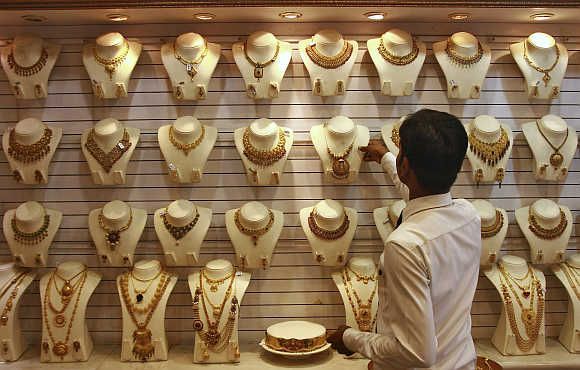
Gold demand hit a six-year low in the second quarter, a World Gold Council report showed on Thursday, as sluggish price movement and the prospect of better returns in equities curbed interest in the metal.
Demand fell 12 per cent to 914.9 tonnes, with declines in China and India accounting for nearly half of the drop, the WGC said.
Globally, jewellery buying fell 14 per cent, investment slid 11 per cent, and central bank buying was 13 per cent lower.
"Jewellery demand came under pressure from negative consumer sentiment, while investment was a casualty of directionless prices and stock market gains," the WGC said.
Chinese consumer demand fell 3 per cent, with consumer sentiment damaged by volatility in equities and concerns over decelerating growth.
With offtake of 216.5 tonnes, China remained the world's biggest gold consumer.
In number two buyer India, jewellery consumption fell 23 per cent as rural incomes were knocked by severe weather, while investment slid 30 percent to a six-year low, hurt by competition from equities and uncertainty over price direction.
Spot gold was heavily rangebound in the second quarter, with the spread between its highs and lows the narrowest of any quarter in eight years. Prices have since dropped sharply, hitting a 5-1/2 year low late last month.
Lower prices should lead to better demand in Asia in the full year, the WGC said.
This week's devaluation of the Chinese yuan is also expected to boost demand, it added.
"One of the big narratives for the development of the global economy is that the renminbi (yuan) will attain an ever greater role in global financial markets," the WGC's market intelligence manager Alistair Hewitt said.
"For it to do that, it needs a floating exchange rate, and it needs to internationalise."
"As that happens we're going to see greater degrees of volatility within currency markets and within financial markets.
"Those factors will ultimately underpin gold demand as people look to hedge their risk."
Consumer demand fell by nearly a quarter in the Middle East in the last quarter, while Turkish buying was down 50 per cent.
US and European consumer demand rose, however, with European investors buying on concerns over Greece.
European bar and coin demand rose 19 percent or 7.3 tonnes, against average declines of 1.7 tonnes across other markets. Investment in European exchange-traded funds rose 6.6 tonnes in Q2, compared to an outflow of nearly 23 tonnes in ETFs globally.
"Demand for bars, coins and ETFs was boosted by the Greek crisis and the possible threat to the stability of the euro area," the WGC said.
In the full year the WGC expects global demand to reach 4,200-4,300 tonnes, it said.
Last year it totalled 4,220 tonnes.
According to another report from Mumbai, India's gold demand during April-June declined 25 per cent to 154.5 tonnes due to unseasonal rains in the first quarter that damaged crops and the shrinking of wedding dates, according to the World Gold Council.
The demand during the second quarter of 2014 stood at 204.9 tonnes, WGC said in Gold Demand Trends report for Q2 2015.
According to another report from Mumbai, India's Q2 2015 gold demand in terms of value fell 26 per cent to Rs 37,590.2 crore (Rs 375.9 billion) compared with Rs 50,778.1 crore (Rs 507.78 billion) in Q2 2014.
"Consumer demand in India fell 25 per cent to 154 tonnes in the April to June quarter, because of a buoyant stock market, a softening rural economy affected by unseasonal heavy rains in Q1, which damaged crops and fewer auspicious days impacting wedding-related demand.
"If, however, we look at the first half of the year, then the fall was only 7 per cent to 346.2 tonnes compared with 372 tonne in the first six months of 2014," WGC Managing Director, India, Somasundaram PR told Press Trust of India in Mumbai.
Especially, small jewellers in tier II and III towns were affected due to this decline in consumer demand, he added.
The demand, however, was robust during festivals like the Akshaya Tritiya, but people showed cautious approach towards gold expecting a weak monsoon, he noted.
Total jewellery demand was down 23 per cent at 118 tonnes compared with 152.6 tonne in the same quarter last year.
The value of jewellery demand fell 24 per cent to Rs 28,703 crore (Rs 287.03 billion) from Rs 37,807 crore (Rs 378.07 billion) in the corresponding period of 2014.
Image: A salesman arranges a gold necklace inside a jewellery showroom in Kochi. Photograph: Sivaram V/Reuters








